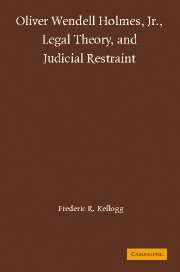Book contents
- Frontmatter
- Contents
- Preface
- 1 A Time for Law
- 2 Playing King: Connections and Misconceptions
- 3 Holmes's Conception of Law
- 4 Common Law Theory Revisited
- 5 Holmes and Legal Classification
- 6 The General Theory of Liability
- 7 Morals and Skepticism in Law
- 8 Judges, Principles, and Policy
- 9 Common Law Constitutionalism
- 10 Holmes's Theory in Retrospect
- 11 Conclusion
- Appendix
- Bibliography
- Index
- Frontmatter
- Contents
- Preface
- 1 A Time for Law
- 2 Playing King: Connections and Misconceptions
- 3 Holmes's Conception of Law
- 4 Common Law Theory Revisited
- 5 Holmes and Legal Classification
- 6 The General Theory of Liability
- 7 Morals and Skepticism in Law
- 8 Judges, Principles, and Policy
- 9 Common Law Constitutionalism
- 10 Holmes's Theory in Retrospect
- 11 Conclusion
- Appendix
- Bibliography
- Index
Summary
I have argued that an overall consistency may be found throughout Holmes's work, in tracing his path from the earlier critical to the later constructive stage of his scholarship, and on into his judicial career. Although his place in American jurisprudence is still controversial, I have suggested that his conception of law may clearly be understood by comparison with contemporary legal positivism, as it has developed from Austin to Hart, bearing a distinct view of the nature and method of law. Having discerned a relationship between law and morals that formerly appeared to be a gloss on John Austin's strict separation, Holmes developed instead what must be described as an original common law theory. Finally, I have claimed that Holmes provides a more comprehensive and compelling approach to judicial restraint than strict textualism and original understanding, grounded as they are in the positivist tradition.
In the following passage from The Supreme Court and the Idea of Progress, Alexander Bickel emphasizes that the Supreme Court does not act as a mechanical interpreter in isolation from the prevailing standards of society at large.
The Supreme Court's judgments may be put forth as universally prescriptive; but they actually become so only when they gain widespread assent. They bind of their own force no one but the parties to a litigation. To realize the promise that all others similarly situated will be similarly bound, the Court's judgments need the assent and the cooperation first of the political institutions, and ultimately of the people.
- Type
- Chapter
- Information
- Oliver Wendell Holmes, Jr., Legal Theory, and Judicial Restraint , pp. 171 - 176Publisher: Cambridge University PressPrint publication year: 2006

